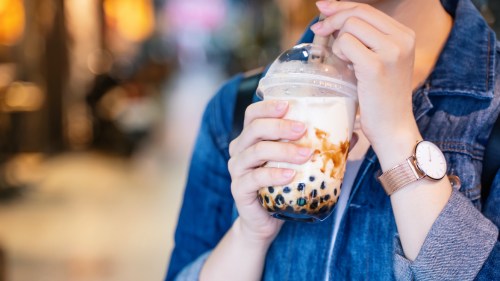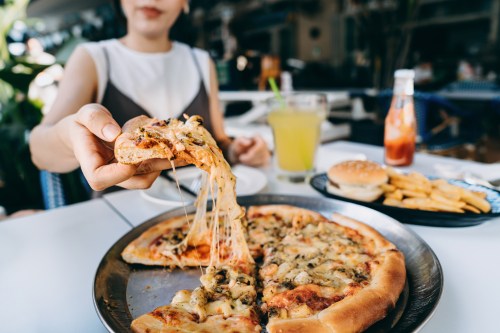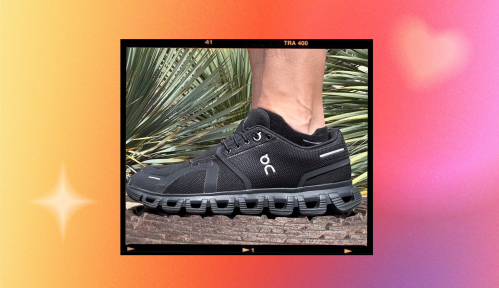Our editors independently select these products. Making a purchase through our links may earn Well+Good a commission
Even if you’ve never actually tried boba tea—also known as bubble tea—there is a good chance you’re familiar with what it is. The delicious milky tea drink made with tapioca pearls has grown in popularity in the U.S. since the ’90s and has a global worth of $2 billion.
Experts in This Article
registered dietitian based in New York
Emre Yenici is the owner and co-founder of Locca Bubble Tea, which sells boba tea-making kits.
Mario DiFalco is the vice president of Del Monte Foods, one of the largest food producers and distributors in the U.S.
To the delight of many, boba tea shops are popping up all across the U.S., and are especially popular in cities like Los Angeles and Miami. (If you’ve stood in a line so long it snaked around the block for your boba fix, you know exactly what we’re talking about.) Another indicator of just how beloved boba tea has become in the U.S.? The fact that this month, food giant Del Monte is releasing the first shelf-stable boba tea, Joyba. While this means the tea will soon be available at a grocery store near you, before you stock up, it’s important to know the origins of the drink as this is a beverage with a rich history. You want to be able to enjoy the delish drink while honoring its roots, right?
Consider this your guide to boba tea. Get ready to be schooled on the history of the drink, nutritional facts, how it’s made, and tips for enjoying it.
What is bubble tea, and what health benefits does it offer?
Boba tea’s roots can be traced back to Taiwan in the early 1980s—pretty recent when you consider that most types of teas have been sipped for centuries. Tea with milk was already a common drink in Taiwan. In the ’80s, two tea shops came up with the idea (independently of each other) to add little tapioca pearls to it. As you can guess, people went wild for the result, and it’s popularity grew quickly across Asia—and in the decades following, across the globe.
Nutrition expert Asako Miyashita, RD, says she remembers first having boba tea in the ’90s, as a teenager living in Japan. She explains that boba tea can be made with different types of tea, most commonly black tea, green tea, or white tea. Besides the tea, the other ingredients are milk, ice, and of course, the chewy tapioca pearls.
Miyashita says when bubble tea is made with these simple ingredients, it is full of nutritional benefits. She explains that black, green, and white tea are all high in antioxidants, which are linked to supporting brain health. Antioxidants reduce inflammation, which helps protect against certain cancers and diseases and is also linked to longevity. Antioxidants protect the brain by reducing oxidative stress, which is detrimental to brain function.
Miyashita says all the tea options have nutritional benefits, so boba tea drinkers should feel free to go with whatever they like the taste of. That being said, she does highlight some specific benefits of choosing green tea. “Green tea contains a catechin called EGCG,” she says. This specific type of catechin has been shown to inhibit tumor growth. White tea has also been shown to protect against neurodegenerative diseases (at least in rats) and both teas have been linked to supporting the immune system. More of a black tea drinker? Black tea is especially good for the gut while also protecting against inflammation and supporting the immune system. Basically, you can’t go wrong.
Curious about those tapioca pearls? Miyashita says while they certainly aren’t unhealthy, their nutritional benefits are minimal. “Tapioca derives from cassava tubers and consists of starchy carbohydrates but fewer fibers. Cassava itself contains nutrients such as vitamin C and calcium, iron—but little,” she says. “When cassava is cooked [as they are when making boba tea], most nutrients are destroyed. That’s why tapioca pearls have fewer health benefits.” So while the pearls are part of the essence of boba tea, they aren’t exactly nutrient rich.
Milk is also a crucial part of boba tea—and if you go with standard cow’s milk, you’re getting good amounts of calcium, protein, vitamin D, and vitamin A. As more people are turning to plant-based milks, options like oat and almond have become available at more bubble tea shops. While alternative milks do have some nutritional benefits, they’re primarily made of water, so the benefits are minimal.
Watch the video below to find out which alternative milk is the healthiest, according to a registered dietitian:
Sometimes boba tea is made with condensed milk, an add-in Miyashita isn’t in favor of nutritionally. “Condensed milk typically contains sugar,” she says. For this reason, she says it’s best to add just a splash to your boba tea, if you choose to add it at all.
How to enjoy boba tea while honoring its roots
Even though boba tea has been around for decades, there hasn’t been a shelf-stable way to enjoy it until this month. Locca Boba Tea founder Emre Yenici says there are a couple of reasons why boba tea is hard to bring to the masses in this way. One reason, he says, is because of the milk; cow’s milk must be kept cold and has a relatively short window of when it must be consumed. “This is why you’ll notice that boba tea is more commonly sold in kits with powder milk for people to make at home,” he says.
Yenici says the other reason is because tapioca pearls take time to cook. “Some brands try to get around this by using instant tapioca pearls which are easier to use, but in my opinion are not as authentic as using the tapioca pearls that require cooking,” he says. Yenici—whose brand sells a variety of boba tea kits—says ingredient sourcing is really important to him as he wants people to make and enjoy boba tea at home as authentically as possible. “We source most of our teas from Taiwan,” he says, adding that the others they use are from other Asian countries.
Del Monte Foods vice president Mario DiFalco says creating a boba tea that honored its Taiwanese roots was of utmost importance to the brand. “We partnered with a Taiwanese supplier for the boba tea ingredients and also put a lot of thought into how the drink would be packaged,” he says. For example, this is one drink they definitely weren’t going to use a can for. Instead, they use cups that come with straws big enough for the pearls to fit through.
DiFalco says it certainly wasn’t easy to figure out how to create a shelf-stable boba tea. As Yenici highlighted, the obstacles are very real. Figuring out the cups themselves, he says, was one hurdle. DiFalco says it was important to the food company that the cups be just like what you’d get at a bubble tea shop, but the straws had to be included in a way where they wouldn’t get unattached to the cup during the shipping process.
Then, of course, was the work of creating boba tea flavors that were authentic and delicious. While the brand’s commitment is honorable, there are some differences between Joyba and traditional boba tea worth noting. The boba bubbles are made from water, sugar, calcium lactate, citric acid, corn starch, and a few other ingredients—an ingredients list similar to the instant tapioca pearls Yenici says some brands turn to in place of tapioca pearls that have to be cooked. It’s also made with brewed tea and calcium lactate, not milk. These changes allow the beverage to not spoil as easily. Ultimately, DiFalco says, he hopes Joyba is a way for people who are already familiar with boba to enjoy it on-the-go while also introducing people who’ve never tried it to the drink.
Yenici reiterates that if you want to enjoy boba tea while honoring its cultural roots, find out where the ingredients are being sourced from; truly authentic boba tea is from Taiwan. This advice is key for whether you’re popping into a local boba tea shop, using a kit to make it at home, or buying it at the grocery store. With that in mind, the fact that boba tea is becoming easier to find is definitely a positive. I mean, how many drinks come accessorized with pearls?
Oh hi! You look like someone who loves free workouts, discounts for cult-fave wellness brands, and exclusive Well+Good content. Sign up for Well+, our online community of wellness insiders, and unlock your rewards instantly.
Sign Up for Our Daily Newsletter
Get all the latest in wellness, trends, food, fitness, beauty, and more delivered right to your inbox.
Got it, you've been added to our email list.










